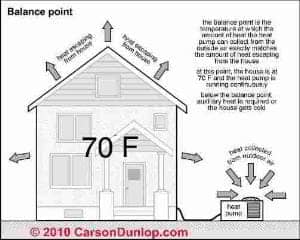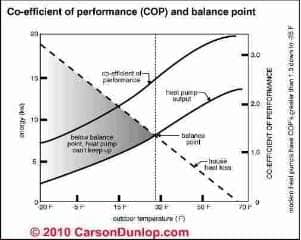 Heat Pump Efficiency, COP
Heat Pump Efficiency, COP
Variables in True Heat Pump Operating Efficiency & Cost
- POST a QUESTION or COMMENT about the definition of heat pump COP and how to calculate true electricity costs when using a heat pump system
Heat pump COP, definitions, efficiency, true electricity cost calculations. This article defines heat pump COP (coefficient of performance) and explains why the operating efficiency of heat pumps varies as a function of outdoor temperature. We include a table of factors used to convert electricity costs to true electricity costs as a function of outdoor degree days in the heating season - a calculation that makes comparison of heat pump operating costs with those of other heating methods much more accurate. Illustration at page top provided by Carson Dunlop Associates, a Toronto home inspection, education & report writing tool company [ carsondunlop.com ].
InspectAPedia tolerates no conflicts of interest. We have no relationship with advertisers, products, or services discussed at this website.
- Daniel Friedman, Publisher/Editor/Author - See WHO ARE WE?
Heat Pump Operating Efficiency COP Definition & Variables
 What is the COP or Coefficient of Performance of Heat Pumps?
What is the COP or Coefficient of Performance of Heat Pumps?
The COP or coefficient of performance describes the ability of a heat pump to extract heat from outdoor air down to some low temperature, typically 25 degF. for modern equipment. The COP determines how effective a heat pump can be at providing heat during cool or cold weather.
The COP or co-efficient of performance for a heat pump can be expressed as a curve showing energy consumed to operate the equipment versus the amount of heat energy provided to the building.
Because COP curves show that we cannot continue to make effective use of a heat pump at very low or very cold outdoor temperatures, a backup heating system is required where heat pumps are installed in cold climates.
Illustration provided by Carson Dunlop Associates, a Toronto home inspection, education & report writing tool company [ carsondunlop.com ].
[Click any image to see an enlarged version and to read details.]
Watch out: As we explain in details at HEAT PUMPS, GROUNDWATER, you can't tell which COP and EER measurement for groundwater based heat pump systems is "right" without additional data describing the testing conditions.
The balance point in a COP curve for a heat pump describes the point beyond which it is not efficient to continue to run the equipment to try to heat a building - because we are obtaining less heat energy to put into the building than the energy we are using to operate the equipment.
Illustrations provided by Carson Dunlop Associates, a Toronto home inspection, education & report writing tool company [ carsondunlop.com ].
Heat Pump operating cost variables & COP Calculations
Where a heat pump is used to provide part of the building's heat requirements, the efficiency of the air-to-air heat pump will be less at lower temperatures.
Spies (1971, 1977) [2] notes that heat pump efficiency when outdoor air is warm is quite different from at cold temperatures, making its use of electricity more complex.
The coefficient of utilization may be as high as 3.0, falling to 1.0 as outdoor temperature approaches 10 degF. In 1971 when Spies wrote that note for the Small Homes Council, few heat pumps worked at temperatures that low, Also that this was in 1971, newer equipment is capable of efficient heat extraction from colder air. Spies provided a calculation to transfer heat pump efficiency or COP into electrical costs when comparing heating fuel type cost alternatives:
Table of Electricity Cost Divisors for Heat Pump Operating Cost vs Degree Days - Outdoor Temperature |
|
| Degree Days for Your Location | Electricity Price Divisor |
| 8000 degree-day heating season | 1.4 |
| 6000 degree-day heating season | 1.7 |
| 4000 degree-day heating season | 2.2 |
Notes to the table above
Henry Spies, "Fuels & Burners", Small Homes Council - Building Research Council Circular Series #G3.5, 1971. 1977
Example: If you live in a climate in which the average number of degree days in the heating season is 4000, then to compare heat pump operating costs (using electricity) to other fuels and heating methods,
divide your current electricity cost (say 5 cents per kwh) by 2.2.
5 / 2.2 = 2.27 cents / kwh
...
Continue reading at HEATING COST FUEL & BTU COST TABLES or select a topic from the closely-related articles below, or see the complete ARTICLE INDEX.
Or see this
Article Series
- HEAT PUMPS
- OPERATING DEFECTS, AIR CONDITIONING
- OPERATING TEMPERATURES HVAC
- RATED COOLING CAPACITY
- SEER RATINGS & OTHER DEFINITIONS
Suggested citation for this web page
HEAT PUMP COP at InspectApedia.com - online encyclopedia of building & environmental inspection, testing, diagnosis, repair, & problem prevention advice.
Or see this
INDEX to RELATED ARTICLES: ARTICLE INDEX to AIR CONDITIONING & HEAT PUMPS
Or use the SEARCH BOX found below to Ask a Question or Search InspectApedia
Ask a Question or Search InspectApedia
Try the search box just below, or if you prefer, post a question or comment in the Comments box below and we will respond promptly.
Search the InspectApedia website
Note: appearance of your Comment below may be delayed: if your comment contains an image, photograph, web link, or text that looks to the software as if it might be a web link, your posting will appear after it has been approved by a moderator. Apologies for the delay.
Only one image can be added per comment but you can post as many comments, and therefore images, as you like.
You will not receive a notification when a response to your question has been posted.
Please bookmark this page to make it easy for you to check back for our response.
IF above you see "Comment Form is loading comments..." then COMMENT BOX - countable.ca / bawkbox.com IS NOT WORKING.
In any case you are welcome to send an email directly to us at InspectApedia.com at editor@inspectApedia.com
We'll reply to you directly. Please help us help you by noting, in your email, the URL of the InspectApedia page where you wanted to comment.
Citations & References
In addition to any citations in the article above, a full list is available on request.
- [1] Thanks also to Alan Carson, Carson Dunlop, Associates, Toronto, for technical critique and for providing a copy of Carson Dunlop Weldon & AssociatesTechnical Reference Guide to manufacturer's model and serial number information for heating and cooling equipment ($69.00 U.S.).
- [2] Henry Spies, "Fuels & Burners", Small Homes Council - Building Research Council Circular Series #G3.5, 1971. 1977 [copy on file as PDF]
- Geothermal HVAC, [Amazon.com] Jay Egg & Brian Howard, McGraw-Hill Professional; ISBN-10: 0071746102, ISBN-13: 978-0071746106, quoting:
This definitive guide covers commercial and residential geothermal heating, ventilation, and air conditioning technologies and explains how to take advantage of their money- and energy-saving features. Geothermal HVAC: Green Heating and Cooling reviews the array of choices currently available, offers market values for systems based on varying options and conditions, and describes how to pair the best systems for each application and budget. Whether you're a contractor or a consumer, you'll find out what you need to know to implement a geothermal HVAC system in a retrofit or new construction project, and start benefiting from this sustainable, affordable technology. - Geothermal Heat Pumps: A Guide for Planning and Installing, [Amazon.com], Karl Ochsner, Robin Curtis, Earthscan Publications Ltd. (December 2007), ISBN-10: 1844074064, ISBN-13: 978-1844074068quoting:
Geothermal Heat Pumps is the most comprehensive guide to the selection, design and installation of geothermal heat pumps available. This leading manual presents the most recent information and market developments in order to put any installer, engineer or architect in the position to design, select and install a domestic geothermal heat pump system. Internationally respected expert Karl Ochsner presents the reasons to use heat pumps, introduces basic theory and reviews the wide variety of available heat pump models. Expertly reviewed and adapted for the most geographically broad application possible, the book offers the reader valuable tips for planning and system control using data, graphics and tables from a growing and innovative market. - Residential Geothermal Systems: Heating And Cooling Using The Ground Below, [Amazon.com], John Stojanowski, Pangea Publications LLC (March 17, 2010)
ISBN-10: 0981922112, ISBN-13: 978-0981922119. Quoting from Amazon.com reviews:
Readers will learn how heat pumps are able to extract heat from relatively low temperature water circulating in ground loops and raise it to a temperature high enough to heat a home. They will also learn how to estimate the size of the heat pump required and the ground loop size as well for straight 2-pipe, 4-pipe, 6-pipe and Slinky loop configurations. This is important in order to verify that the installer correctly sizes the system. Both horizontal and vertical loop systems, for GX and DX, are covered.
Some of the technical issues that are addressed include: Loop water flow rates and Reynolds Number, heat of extraction/rejection, heating capacity, de-superheater setup, open-loop/closed-loop, SCW, pond loops, DX, Manual-J, COP. The final chapter consists of a set of flowcharts guiding the homeowner to ask the pertinent questions needed for a successful installation.
- Our recommended books about building & mechanical systems design, inspection, problem diagnosis, and repair, and about indoor environment and IAQ testing, diagnosis, and cleanup are at the InspectAPedia Bookstore. Also see our Book Reviews - InspectAPedia.
- In addition to citations & references found in this article, see the research citations given at the end of the related articles found at our suggested
CONTINUE READING or RECOMMENDED ARTICLES.
- Carson, Dunlop & Associates Ltd., 120 Carlton Street Suite 407, Toronto ON M5A 4K2. Tel: (416) 964-9415 1-800-268-7070 Email: info@carsondunlop.com. Alan Carson is a past president of ASHI, the American Society of Home Inspectors.
Thanks to Alan Carson and Bob Dunlop, for permission for InspectAPedia to use text excerpts from The HOME REFERENCE BOOK - the Encyclopedia of Homes and to use illustrations from The ILLUSTRATED HOME .
Carson Dunlop Associates provides extensive home inspection education and report writing material. In gratitude we provide links to tsome Carson Dunlop Associates products and services.

